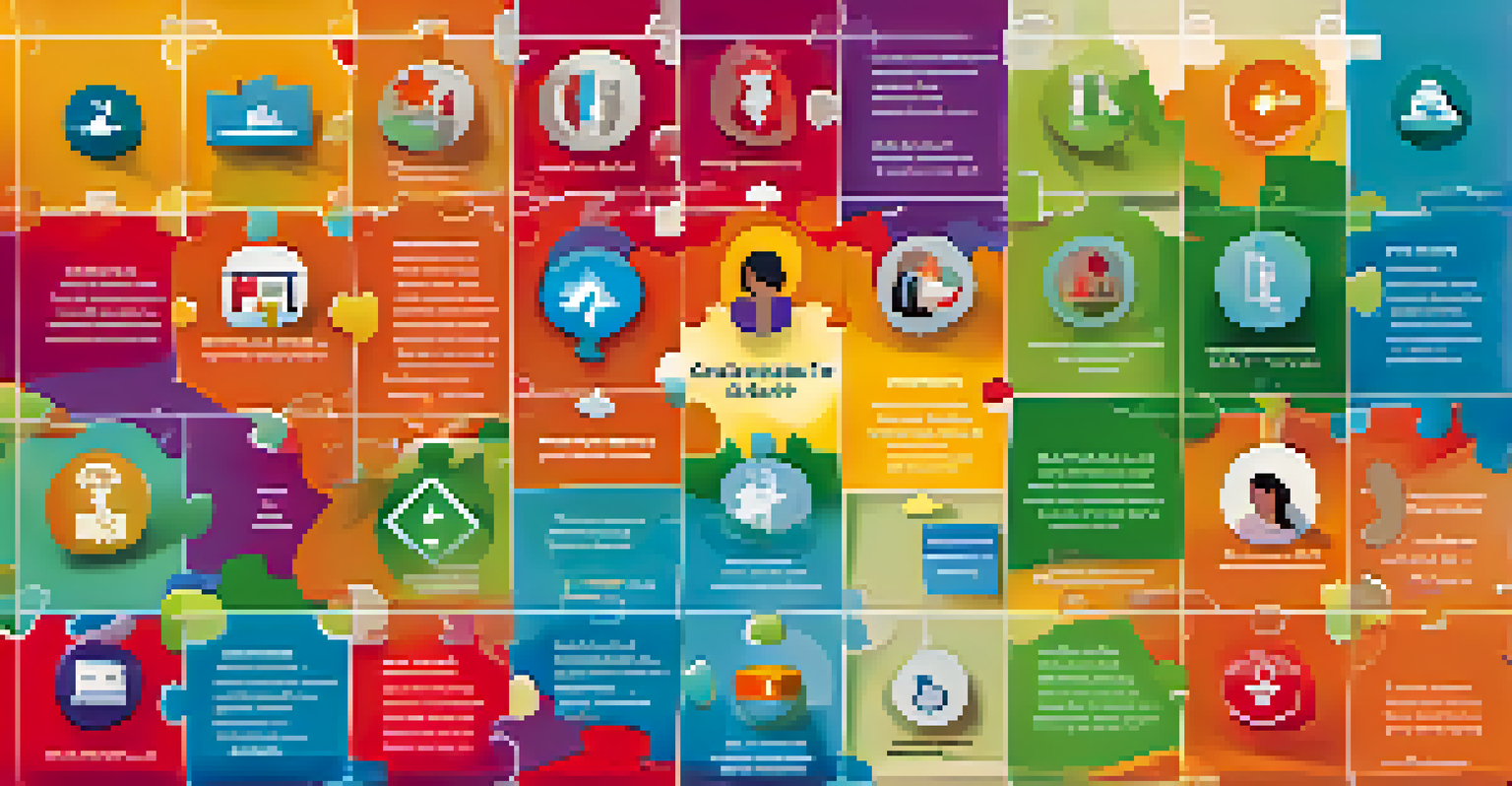Partnerships Between Organizations for Addiction Solutions

Understanding the Need for Collaborative Solutions
Addiction is a complex issue that affects individuals, families, and communities. No single organization can address it alone; hence the need for partnerships. By joining forces, organizations can leverage their strengths and resources to provide comprehensive support for those struggling with addiction.
Alone we can do so little; together we can do so much.
For instance, a treatment center might partner with local healthcare providers to ensure patients receive medical attention alongside therapy. This synergy not only improves patient outcomes but also streamlines the recovery process, making it more accessible. Collaboration fosters a holistic approach, embracing various aspects of care.
Furthermore, partnerships can enhance outreach efforts, allowing organizations to connect with more individuals in need. When various entities work together, they can share knowledge, strategies, and networks, ultimately reaching a broader audience and making a bigger impact.
Types of Organizations That Can Collaborate
Partnerships can form between a variety of organizations, including non-profits, healthcare systems, educational institutions, and community groups. Each entity brings its unique perspective and resources to the table. For example, a local school might work with a rehabilitation center to educate students about the dangers of substance abuse.

Additionally, government agencies can collaborate with non-profit organizations to create policies that support addiction recovery programs. This kind of alliance can lead to more funding and resources, which are crucial for effective interventions. The diverse backgrounds of these organizations can lead to innovative solutions that might not emerge in isolation.
Collaborative Solutions for Addiction
Partnerships among various organizations enhance support and resources for individuals struggling with addiction.
Moreover, businesses can play a role in these partnerships by offering employment opportunities for those in recovery. This not only helps individuals reintegrate into society but also promotes a sense of community responsibility and engagement in the fight against addiction.
Examples of Successful Partnerships in Action
One notable example is the collaboration between the Substance Abuse and Mental Health Services Administration (SAMHSA) and local community organizations. This partnership has created programs that provide resources, education, and support for addiction treatment across various demographics. By pooling resources, they have seen significant improvements in recovery rates.
Collaboration allows us to know more than we are capable of knowing by ourselves.
Another successful initiative is the partnership between law enforcement and treatment facilities. Some police departments have implemented programs that divert individuals with substance use disorders into treatment instead of jail. This not only addresses addiction but also reduces the burden on the criminal justice system, showing a compassionate approach to a significant societal issue.
These examples illustrate how effective partnerships can create sustainable solutions. By working together, organizations can develop innovative programs that address the multifaceted nature of addiction, combining enforcement, education, and rehabilitation.
Challenges Faced in Forming Partnerships
While partnerships can be incredibly effective, they also come with challenges. Differing organizational cultures and priorities can lead to misunderstandings and conflicts. For instance, a non-profit focused on prevention may have different goals than a treatment facility focused on recovery, making alignment difficult.
Moreover, resource allocation can be a contentious issue. Organizations may struggle to agree on how to distribute funding or personnel, which can hinder collaboration. Clear communication and well-defined roles are essential to navigate these challenges and ensure that all parties are on the same page.
Diverse Collaborators Drive Change
Non-profits, businesses, and government agencies can unite to innovate solutions and broaden the impact on addiction recovery.
Additionally, the stigma surrounding addiction can pose barriers to forming partnerships. Some organizations may hesitate to align themselves with addiction-focused initiatives, fearing backlash or negative perceptions. Overcoming these societal attitudes requires persistent advocacy and education to highlight the importance of collaborative efforts.
Best Practices for Successful Partnerships
To foster successful partnerships, organizations should prioritize open communication from the outset. Establishing clear goals and expectations helps to ensure that all parties understand their roles and responsibilities. Regular check-ins and updates can keep everyone aligned and engaged.
Building trust is another critical component. Organizations should be transparent about their capabilities and limitations, fostering a sense of mutual respect. Sharing success stories and celebrating milestones together can strengthen relationships and encourage further collaboration.
Finally, flexibility is key. As needs evolve and circumstances change, partners should be willing to adapt their strategies. By remaining open to new ideas and approaches, organizations can ensure that their partnerships remain effective and relevant over time.
Measuring the Impact of Collaborative Efforts
Assessing the effectiveness of partnerships is essential to ensure they are making a difference. Organizations can establish key performance indicators (KPIs) to track progress, such as the number of individuals served, recovery rates, or community awareness levels. These metrics provide valuable insights into what works and what needs improvement.
Feedback from participants is also crucial. Gathering testimonials from those who have benefited from these partnerships can help organizations understand their impact more deeply. Listening to the voices of those affected allows for adjustments to be made that can enhance the effectiveness of programs.
Challenges and Best Practices
Navigating differing goals and stigma is crucial for successful partnerships, emphasizing the need for communication and flexibility.
Moreover, sharing these findings with stakeholders can help secure ongoing support and funding. Demonstrating the positive outcomes of collaborative efforts not only strengthens existing partnerships but also attracts new allies in the fight against addiction.
Looking Ahead: The Future of Collaborative Addiction Solutions
As the landscape of addiction continues to evolve, so too must the partnerships formed to address it. Future collaborations will likely incorporate technology, such as telehealth services, to reach individuals in remote areas. This innovation can expand access and provide support to those who might otherwise fall through the cracks.
Moreover, as awareness of mental health issues grows, partnerships that integrate mental health services with addiction treatment will become increasingly vital. This holistic approach recognizes the interconnectedness of these issues and aims to address them simultaneously, leading to more sustainable recovery outcomes.

Ultimately, the future of addiction solutions lies in the hands of collaborative efforts. By continuing to build and strengthen partnerships, organizations can create a more supportive environment for recovery, ensuring that help is available to those who need it most.